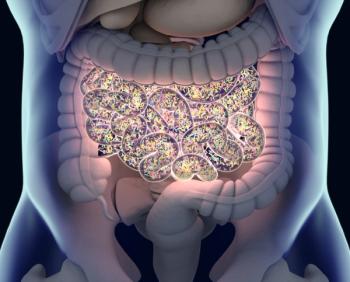
ctDNA Does Not Confer Chemo Efficacy in Stage II CRC Following Surgery
Adjuvant chemotherapy does not yield an improvement in ctDNA clearance compared with observation among patients with stage II colon cancer in the phase 2/3 COBRA trial.
Circulating tumor DNA (ctDNA) positivity following surgery did not appear to predict efficacy with adjuvant chemotherapy among those with low-risk stage II colon cancer, according to findings from the phase 2/3 COBRA trial (NCT04068103) presented at the
“To date, the field does not have full validation of proof using prospective clinical trials of ctDNA across all the various contexts of colorectal cancer,” Van K. Morris, MD, associate professor, Department of Gastrointestinal Medical Oncology, The University of Texas MD Anderson Cancer Center in Houston, said during a presentation of the data.
A total of 635 patients were randomly assigned to receive either ctDNA assay directed therapy (n = 317) or standard-of-care active surveillance (n = 318). Patients in the treatment arm received 6 months of either CAPOX (capecitabine and oxaliplatin; n = 4) or FOLFOX (leucovorin calcium [folinic acid], fluorouracil, and oxaliplatin; n = 12) if ctDNA was detected; if ctDNA was not detected, patients underwent active surveillance. The primary end point of the trial was clearance of ctDNA at the 6-month time point. Secondary end points were median overall survival, recurrence-free survival, and time to response. The Guardant LUNAR assay was used to determine ctDNA.
For patients in the treatment arm who were prospectively identified as having ctDNA detected, treatment was started between 4 and 12 weeks after surgery and final blood collection occurred immediately prior to the final dose of chemotherapy.
ctDNA clearance between the 2 arms was determined using a 1-sided Fisher exact test. The investigators noted that if the P-value was greater than .35, the study would be stopped for futility but would continue to phase 3 if the P-value was .35 or lower.
At the primary end point analysis, results of the first 16 patients with ctDNA detected at baseline were reviewed. ctDNA clearance after 6 months was observed in 11% of patients (1 of 9) in the treatment arm (95% CI, 0.3%-48%) and 43% of patients (3 of 7) in the control arm (95% CI 10%-82%; P = .98). One patient with ctDNA detected in the treatment arm did not receive the protocol-directed chemotherapy but was included in the intention-to-treat analysis.
“Because the 1-sided Fisher’s Exact test yielded a P-value of .98, which exceeded our predefined threshold of .35, we were required to stop the trial early due to futility,” Morris said.
Patients were eligible for the trial if they were candidates for active surveillance (ie, no adjuvant chemotherapy) at the discretion of the treating oncologist, had undergone complete resection of the tumor within 14 to 60 days of study randomization, had an ECOG performance status of 0 or 1, and had adequate hematologic, hepatic, and renal function. “Patients were not allowed to have had prior testing of CT DNA for assessment of colorectal cancer outside of study conduct prior to registration, nor were they allowed to have had any prior history of colon or rectal second cancer,” Morris said.
There was no difference in baseline demographic characteristics between the treatment and control arms, Morris noted. “Further, we did not observe any unexpected toxicities,” he continued. Two patients (50%) who received CAPOX experienced grade 3 diarrhea and 1 patient (8%) who received FOLFOX experienced grade 4 neutropenia.
Morris noted that throughout the course of the trial, investigational sites observed steady enrollment, despite the initial launch during the COVID-19 pandemic in March 2020.
“We believe that this precedent confirms that prospective randomized control trials assessing circulating tumor DNA as an integral biomarker and as a surrogate for minimal residual disease are not only feasible, but remain necessary for us to test and confirm clinically relevant hypotheses in oncology,” Morris explained.
Morris concluded by noting that “using the selected ctDNA assay in this clinically low-risk population, we did not observe an improvement in ctDNA clearance with 6 months of adjuvant chemotherapy, relative to surveillance.”
Reference
Morris VK, Yothers G, Kopetz S, et al. Phase II results of circulating tumor DNA as a predictive biomarker in adjuvant chemotherapy in patients with stage II colon cancer: NRG-GI005 (COBRA) phase II/III study. J Clin Oncol. 2024;42(suppl 3):5. doi:10.1200/JCO.2024.42.3_suppl.5.
Newsletter
Stay up to date on recent advances in the multidisciplinary approach to cancer.






























































































